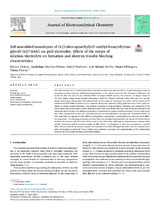Self-assembled monolayers of O-(2-Mercaptoethyl)-O′-methyl-hexa(ethylene glycol) (EG7-SAM) on gold electrodes. Effects of the nature of solution/electrolyte on formation and electron transfer blocking characteristics
Autor
Chávez, Miriam
Sánchez-Obrero, Guadalupe
Madueño, Rafael
Sevilla, José Manuel
Blázquez, Manuel
Pineda, Teresa
Editor
ElsevierFecha
2022Materia
Polyethylene glycolSelf-assembled monolayer
Gold electrode
Cyclic voltammetry
Electrochemical impedance spectroscopy
Contact angle measurements
METS:
Mostrar el registro METSPREMIS:
Mostrar el registro PREMISMetadatos
Mostrar el registro completo del ítemResumen
The self-assembly of O-(2-Mercaptoethyl)-O’-methyl-hexa(ethylene glycol) (EG7) on gold substrates produces monolayers whose structure should depend primarily on the solvents used for their formation. Although this should be also the case for any self-assembled monolayer (SAM) system, the presence of oxygen atoms in the EG7 chains brings about specific interactions with the solvent molecules other than just the van der Waals interactions taking place with alkanethiols. In this work we investigate the effects of the nature of the solutions for EG7-SAM formation in the reductive desorption processes using gold substrates either polycrystalline or single crystal electrodes. The patterns obtained in polycrystalline substrates are compared to the peaks observed at gold single crystal electrodes and it has been found that the main peaks correspond to the molecules desorbed from the different gold facets contained in the polycrystalline substrate. These single peaks are in fact composed of at least two contributions that can be explained as the presence of domains where the EG7 molecules are organized with different orientations, giving place to intermolecular interactions of different magnitude. The blocking properties of these films are strongly determined by the nature of the electrolyte used for the analysis and not by the solvent used in their formation. Although no experimental evidence of the specific interaction and/or retention inside the film of Na+ or phosphate or both ions is obtained, a specific effect that accounts for an electron transfer rate constant of an order of magnitude lower than the obtained with other electrolytes is observed. These results can contribute to increase the understanding of the relationship between the EG7-SAMs structure and functionalities.

